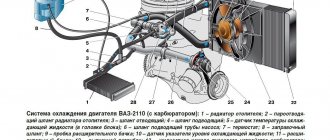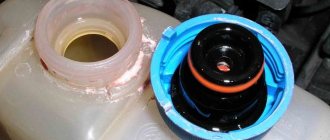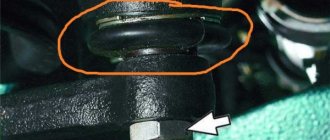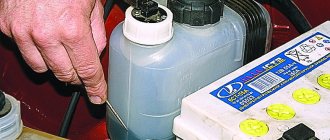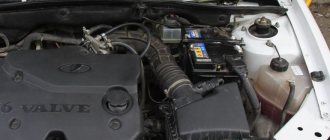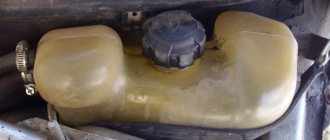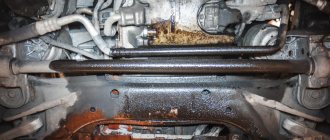Such a small part as the expansion tank cap, unfortunately, almost always causes the least suspicion when any malfunction of the cooling system occurs. The expansion tank cap plays an important role in engine cooling. Its design allows you to regulate the pressure in the cooling system and maintain the correct temperature. Its malfunction can lead to a coolant leak or some kind of engine damage.
Causes of failure of tanks VAZ 21102115
The service life of this element is not limited by regulations. This means that the container should be changed as needed, and this occurs quite often. The most common reason for replacement is damage to the integrity of the plastic case during operation. The tank simply bursts and here's why:
- Clogged or damaged lid valve. The steam coming from the radiators increases the pressure inside the tank because it cannot escape through the plug. As a result, the wall of the container is destroyed.
- In VAZ 2110-12 cars, the side walls of the vessel are closely adjacent to the body elements - the glass and the partition. As the antifreeze temperature and pressure in the system increase, the plastic has nowhere to swell, causing the body to burst along the seam at the end (usually in the lower corner).
- In the event of a breakdown of the gasket between the cylinder head and the engine block, the cooling system is subjected to a series of water hammers created by the movement of the pistons. The plastic case also often bursts from such an impact.
- The reason may be the expansion tank itself, made from low-quality raw materials or in violation of plastic molding technology.
To avoid destruction of the expansion tank, it is recommended to check the functionality of the plug valve before each long trip. Practice shows that problems with the tank most often arise on the road, when it is hot outside, that is, in the summer. A sign of a malfunction is a sharp increase in coolant temperature and a puddle under the engine compartment on the driver’s side.
Some useful tips
To prevent a malfunction of the expansion tank from taking you by surprise, follow these recommendations:
- Constantly pay attention to the readings of the coolant temperature sensor. If you find that the permissible values are exceeded, immediately go for diagnostics or check the functionality of the tank yourself.
- At least once a month, inspect the expansion tank when the engine is hot to identify damage.
- Monitor the refrigerant level. Having detected its fall, find and eliminate the cause of the leak.
- If the refrigerant boils in the tank, do not continue driving under any circumstances - this will damage the engine.
- When planning to replace the tank, buy products from trusted manufacturers in specialized stores.
Why did it happen
Communities Lada Priora Lada Priora Club Blog what is affected by the clutch release switch
Perhaps the automatic requests do not belong to you, but to another user accessing the network from the same IP address. You need to enter the characters into the form once, after which we will remember you and be able to distinguish you from other users exiting from this IP. In this case, the page with the captcha will not bother you for quite a long time.
You may have add-ons installed in your browser that can make automatic search requests. In this case, we recommend that you disable them.
It is also possible that your computer is infected with a virus program that is using it to collect information. Maybe you should check your system for viruses.
If you have any problems or would like our support team, please use the feedback form.
Location of expansion tank
Communities Lada Priora Lada Priora Club Blog Ignition switch wires
A plastic reservoir for excess coolant is installed by the manufacturer in different places depending on the model of the “tenth” family:
- in cars of the VAZ 2110-12 series, the reservoir is located on the left side (in the direction of travel) between the pillar glass and the wall of the interior partition;
- in VAZ 2114-15 cars, the container is also located on the driver’s side, but is placed in front of the pillar glass.
The expansion tank is attached to the body elements with a clamp in the form of a flat rubber belt with a metal hook that hooks onto a protrusion on the side member. There are 3 hoses connected to the tank:
- A large diameter pipe leading from the thermostat is connected to the bottom.
- The upper tube of small diameter goes through the partition to the radiator of the cabin heater.
- The middle small tube connects the tank to the upper fitting of the main cooling radiator.
Each hose performs a separate function. The thick pipe serves to expand the coolant and fill the system while pouring antifreeze through the neck of the tank. Two thin tubes are designed to drain the steam-water mixture from the stove and the main radiator into the tank when heated to the maximum permissible antifreeze temperature of 95 ° C.
The expansion tank (item 1) is located at the highest point of the cooling system at the same level as the throttle valve
Replacing the expansion tank.
Replacing the expansion tank.
Communities Lada Priora Lada Priora Club Blog Ignition coil
For various reasons, the expansion tank of the Lada Priora cooling system becomes unusable.
This usually happens in winter, when the fragility of the plastic parts of the Lada Priora car increases and careless or involuntary application of great forces and impacts leads to cracks or crumbling of the plastic parts
An important place in the expansion tank of a Lada Priora car is occupied by the expansion tank cap. It's not just a black plastic screw cap
The expansion tank cap plays a significant role in the normal operation of the Lada Priora engine.
When a car owner does not use water to cool the Lada Priora engine instead of the required coolant according to GOST, then nothing happens to the safety valve located in the expansion tank cap. This has been tested by time (more than seven years of operation of the Lada Priora from scratch). You can look at the pictures that I posted just above.
The valve in the expansion tank cap is designed to create excess pressure in the cooling system of the Lada Priora engine so that the coolant does not boil and does not form air bubbles in the cooling system. Typically, in the Lada Priora cooling system, the excess pressure fluctuates around 1.1-1.5 kgf/cm2.
Checking the technical condition of the valve in the expansion tank cap is quite simple and does not require much skill. Pry off the sealing gasket (be careful here and do not damage the gasket when removing it) and holding the valve protective casing with your hands from shooting out by the springs, since it is compressed during assembly, it can be easily and simply disassembled.
Some people advise upgrading this valve by simply biting off the valve spring and thereby reducing the technical performance of a normally functioning valve. Do you want to put a puzzled sign here?! and say why. At the factory, the valves are selected on benches and withstand the pressure required for normal operation of the Lada Priora engine under different modes.
I want to say again that all your work consists of visually inspecting the springs and valve holes for clogging and rust (although this is simply impossible in coolant, if not water).
If you did not find anything during inspection (clogging, warping, drying out, accumulation of various deposits...), then you need to tighten the cap of the expansion tank tightly and fairly decently. Thus, you eliminate many unnecessary questions when repairing the engine cooling system.
And for those who are haunted by the modernization of the expansion tank cap, I will say that to each his own...
Replacing the expansion tank; You will need a Phillips-blade screwdriver.
Refinement of the cover
Some people modify the covers by trimming the valve springs by a few turns. I don't recommend doing this. This is not such an expensive part that you would bother with it so much.
If the lid does not work, you can always return it to the store and try another one. Some people spend quite a long time searching for a lid until they find the right one. This is due to the fact that (in most cases) there are many fakes, as well as for other reasons, for example, the buyer does not read the response temperature of the valve on the lid, fills in cheap antifreeze or water, which has a detrimental effect on the cooling system.
Replacing the expansion tank on a Lada Priora
style=”line-height:19px;text-indent:NULLem;text-align:left”>>
p>
style=”line-height:19px;text-indent:NULLem;text-align:left”>>Almost all owners of domestic vehicles know what it is to repair a Lada Priora with their own hands - after all, auto repair shop services are not cheap, so you have to figure it out yourself forces. Fortunately, today you can easily find recommendations on how to check or replace a particular car
node.Purpose
style=”line-height:19px;text-indent:NULLem;text-align:left”>>The purpose of the expansion tank is to compensate for the volume of coolant that changes depending on its temperature. Briefly, the device of the expansion tank can be described as follows. The material of the expansion tank is transparent plastic. There are special marks on its walls that help control the coolant level - minimum and maximum. So, the expansion tank cap on the Lada Priora is located in the neck located on top. A plastic stopper seals the neck. The plug itself also contains two valves assembled into a single block - inlet and outlet. The release valve is activated when the pressure in the expansion tank reaches 110 kPa. Opening the exhaust valve increases the boiling point of the coolant, thereby preventing intense vaporization. When the coolant cools, its volume decreases, thereby creating a vacuum in the system. The inlet valve is activated when a certain vacuum level is reached and allows air into the expansion tank.
style=”line-height:19px;text-indent:NULLem;text-align:left”>>Often, the expansion tank is repaired only if it is found to be leaking
However, it is important to monitor the proper operation of both the thermostat and valves. For example, if the coolant boils, it is imperative to check the functionality of the valves
In particular, leakage of the exhaust valve will lead to a decrease in the boiling point of the coolant, and jamming of the same valve in the closed state will lead to a problem such as an emergency increase in pressure in the system. This, in turn, can cause damage to the hoses and radiator.
style=”line-height:19px;text-indent:NULLem;text-align:left”>>
Implementation
style=”line-height:19px;text-indent:NULLem;text-align:left”>>In particular, replacing the expansion tank on a Priora is done as follows:
- A Phillips screwdriver should be used as the main tool. First of all, remove the expansion tank plug. To do this, you need to unscrew the drain plug at the bottom of the radiator tank on the right side and drain the liquid from it. By the way, replacing the coolant must be carried out according to all the rules - for example, you cannot mix different coolants. After draining is completed, the drain plug should be tightened. It should be noted that if you drain the liquid not from the tank, but from the radiator (during its repair), then all the liquid from the tank will also flow out,
- it is necessary to loosen the clamp securing the steam exhaust hose of the heater radiator and remove the hose from the expansion tank fitting,
- in the same way, it is necessary to remove the steam exhaust hose of the radiator of the cooling system (also from the expansion tank fitting),
- After loosening the clamp of the charging hose, this part can be easily disconnected,
- expansion tank, to remove it you need to move it up and at the same time remove its rear edge from the recess of the engine shield trim. This way it can be easily removed from the car.
- It is necessary to drain the remaining coolant from the reservoir.
style=”line-height:19px;text-indent:NULLem;text-align:left”>>The expansion tank is installed back in the opposite order of removal. The cooling system should be filled with liquid, taking into account all the standard requirements for this procedure. Then you need to tighten the cap of the expansion tank, start the engine, after which you should check that there are no coolant leaks at the junction of the tank hoses. The engine must be warmed up to operating temperature at idle speed - this will allow air pockets to be removed from the system.
Features of the expansion tank
This device has two main parts:
- The case is plastic.
- Cover with pressure valve.
The quality of the plastic used to make the case plays a special role. Maintaining the pressure required by the system depends 50% on its plasticity.
Attention! When purchasing a new expansion tank, you must carefully check the quality of the connections at the joints! It is in these places that antifreeze under pressure can break through
Expander Configuration
It has four holes. The lower, large outlet is the pipe for the coolant to enter the line. Small tubes are used to return tasol from the area of the heater radiator and thermostat pipe. Well, and the main neck, which is closed with a special lid. But the remaining 50% is ensured by the correct operation of the valve in the expansion tank cap.
How does the expansion tank cap work?
The principle of its operation is relatively simple. It is based on a soldier valve system. That is, in the system, pressure rises from heating and expansion of the coolant. The spring in the cover is adjusted in such a way that when the optimal value is reached, the valve opens and releases excess air in the cooling system. In this case, air should flow freely in the opposite direction. This allows the components to be preserved during cooling. For example, when the engine is turned off.
Signs and possible consequences of a part malfunction
Most often, the consequence of a malfunction of the cap is boiling of the coolant, sometimes accompanied by the ejection of the coolant from the expansion tank - a common occurrence for VAZ cars. If this happens at engine operating temperatures, then most likely the plug does not hold the required pressure.
Car coolant boiling
Another reason for the same phenomenon is that due to a malfunction of the vacuum valve, air entered the ODS and formed a plug, which disrupts normal circulation, and therefore the cooling of the coolant. In winter, due to an air lock, the stove may not work well. Unpleasant consequences: loss of coolant, which has to be topped up regularly. This happens when, due to increased pressure in the SOD, liquid is “expelled” through the joints between the fittings and pipes put on them, through clamps.
Disastrous consequences:
- rupture of low-quality pipes or those that have not been changed for a long time (a picture familiar not only to VAZ owners);
- the appearance of a leak in the main or heating radiator;
- tears the thermostat housing (for Nexia it’s a common thing - into 2 parts);
- burst expansion tank.
A leak appears in the main radiator
All these signs and consequences of a malfunctioning lid are the result of increased pressure in the SOD. The latter is not uncommon for VAZ 2108, 2109 and especially 2110 cars with new-style tanks. Of course, it is obvious that the plastic of these expansion tanks leaves much to be desired, but, nevertheless, this is also due to a malfunction of the plug. So the lid, by regulating the pressure in the SOD, also protects its elements from mechanical damage.
